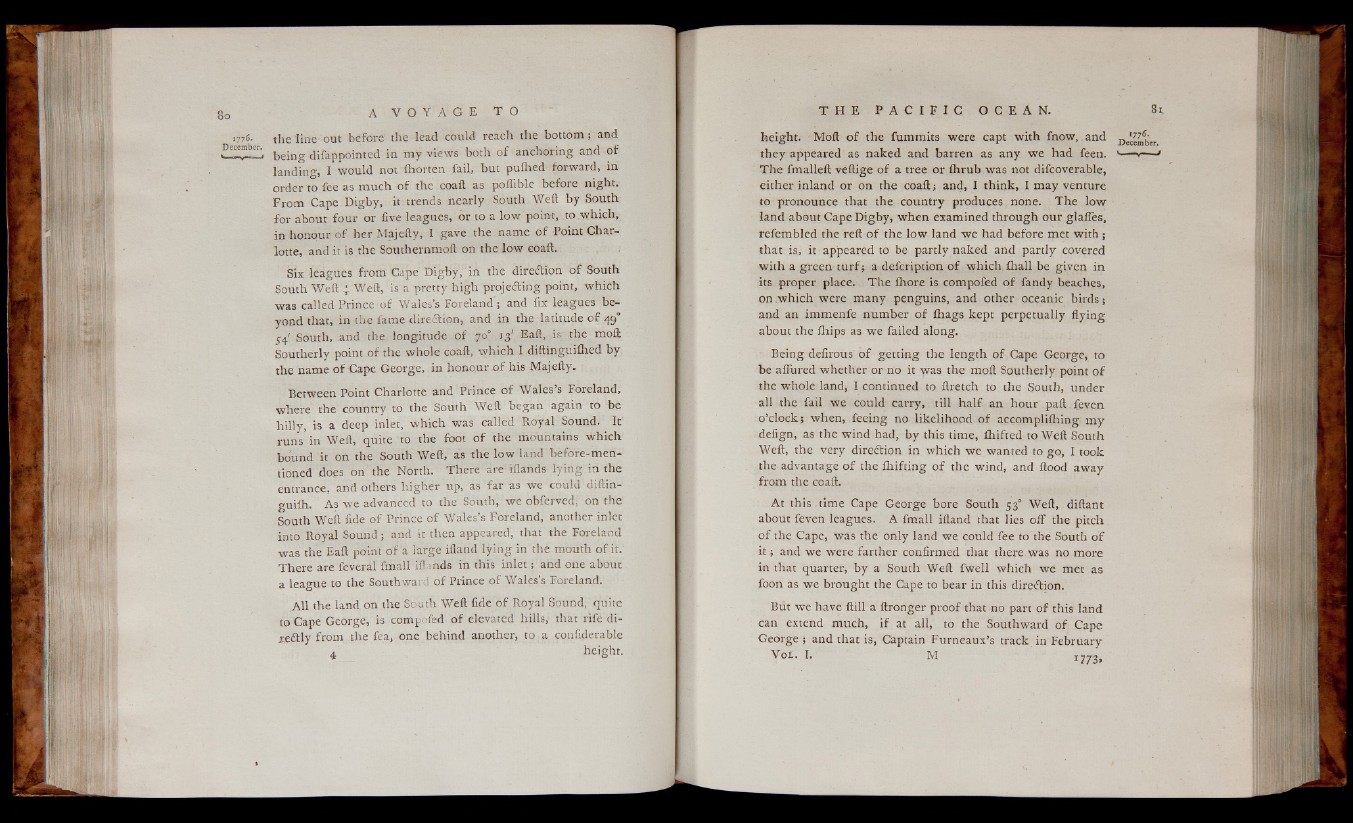
8o A V O Y A G E T O
1776. the line out before the lead, could reach the bottom; and
being difappointed in my views both of anchoring and of
landing, I would not ihorten fail, but puihed forward, in
order to fee as much of the coaft as poffible before night.
From Cape Digby, it trends nearly South Weft by South
for about four or five leagues, or to a low point, to which,
in honour of her Majefty, I gave the name of Point Charlotte,
and it is the Southernmoft on the low coaft.
Six leagues from Cape Digby, in the direction of South
South Weft 4. Weft, is a pretty high projecting point, which
was called Prince of Wales’s Foreland; and fix leagues beyond
that, in the fame direction, and in the latitude of 49°
54' South, and the longitude of 70° 13' Kail, is; the moft
Southerly point of the whole coaft, which I diftinguifhed by
the name of Cape George, in honour of his Majefty.
Between Point Charlotte and Prince of Wales s Foreland,
where the country to the South Weft began again to be
hilly, is a deep inlet, which was called Royal Sound. It
runs in Weft, quite to the foot of the mountains which
bound it on the South Weft, as the low land before-mentioned
does on the North. There are iilands lying in the
entrance, and others higher up, as far as we could diftin-
guiih. As we advanced to the South, we obferved; on the
South Weft fide of Prince of Wales's Foreland, another inlet
into Royal Sound; and it then appeared, that the Foreland
was the Eaft point of a large ifiand lying in the mouth of it.'
There are feveral fmall iilands in this inlet; and one about
a league to the Southward of Prince of Wales’s Foreland.
All the land on the South Weft fide of Royal Sound, quite
to Cape George, is compofed of elevated hills, that rife di-
Xe£Uy from the fea, one behind another, to a confiderable
4 height.
height. Moft of the fummits were capt with fnow, and
they appeared as naked and barren as any we had feen.
The fmalleft veftige of a tree or fhrub was not difcoverable,
either inland or on the coaft j and, I think, I may venture
to pronounce that the country produces none. The low
land about Cape Digby, when examined through our glafles,
refembled the reft of the low land we had before met with;
that is, it appeared to be partly naked and partly covered
with a green turf; a defcription of which ffiall be given in
its proper place. The fhore is compofed of fandy beaches,
on .which were many penguins, and other oceanic birds;
and an immenfe number of ihags kept perpetually flying
about the fhips as we failed along.
Being defirous of getting the length of Cape George, to
be affined whether or no it was the moft Southerly point of
the whole land; I continued to ftretch to the South, under
all the fail we could carry, till half an hour paft feven
o’clock; when, feeing no likelihood of accompliffiing my
defign, as the wind had, by this time, ffiifted to Weft South
Weft, the very direction in which we wanted to go, I took
the advantage of the ffiifting of the wind, and flood away
from the coaft.
At this .time Cape George bore South 530 Weft, diftant
about feven leagues. A fmall ifland that lies off" the pitch
of the Cape, was the only land we could fee to the South o f
i t ; and we were farther confirmed that there was no more
in that quarter, by a South Weft fwell which we met as
foon as we brought the Cape to bear in this direction.
But we have ftill a ftronger proof that no part of this land
can extend much, if at all, to the Southward o f Cape
George ; and that is, Captain Furneaux’s track in February
V ol. I. M 1773,